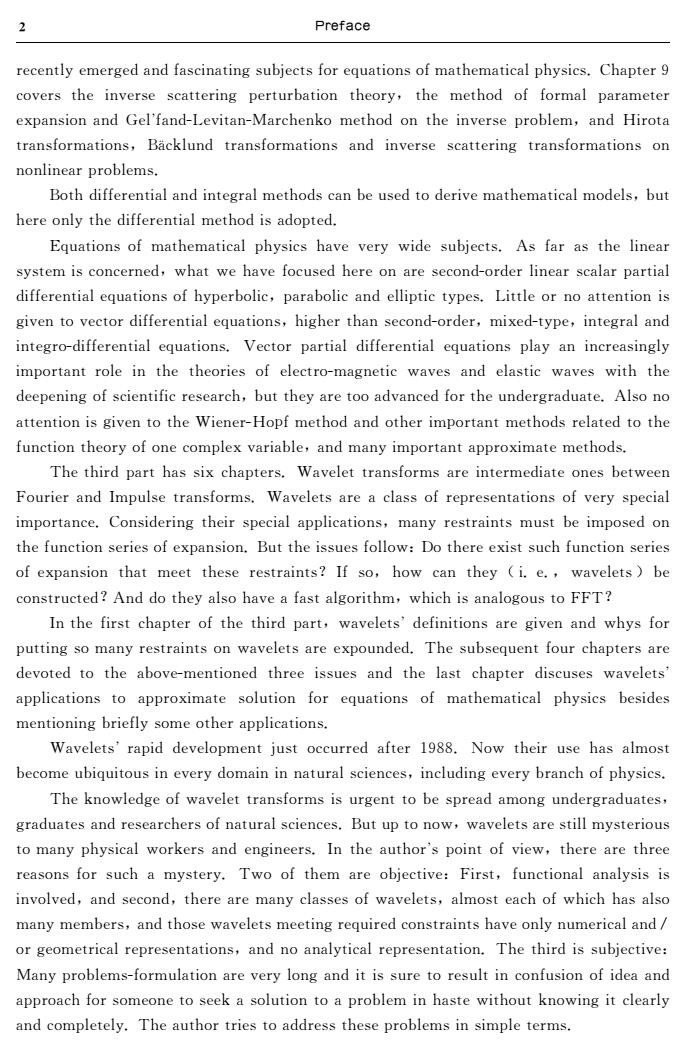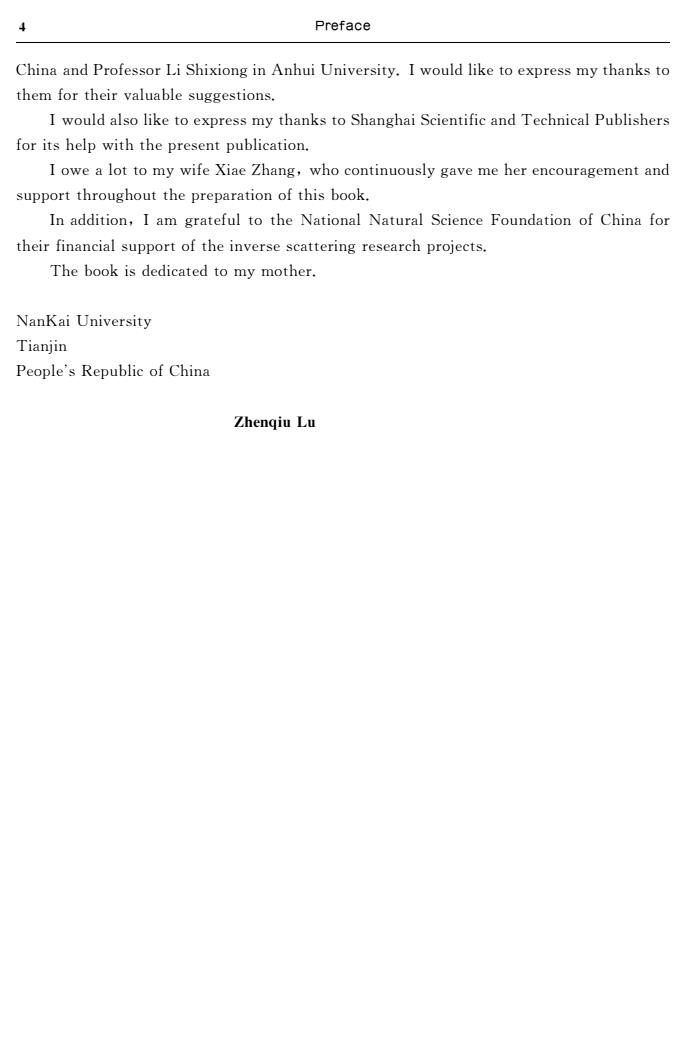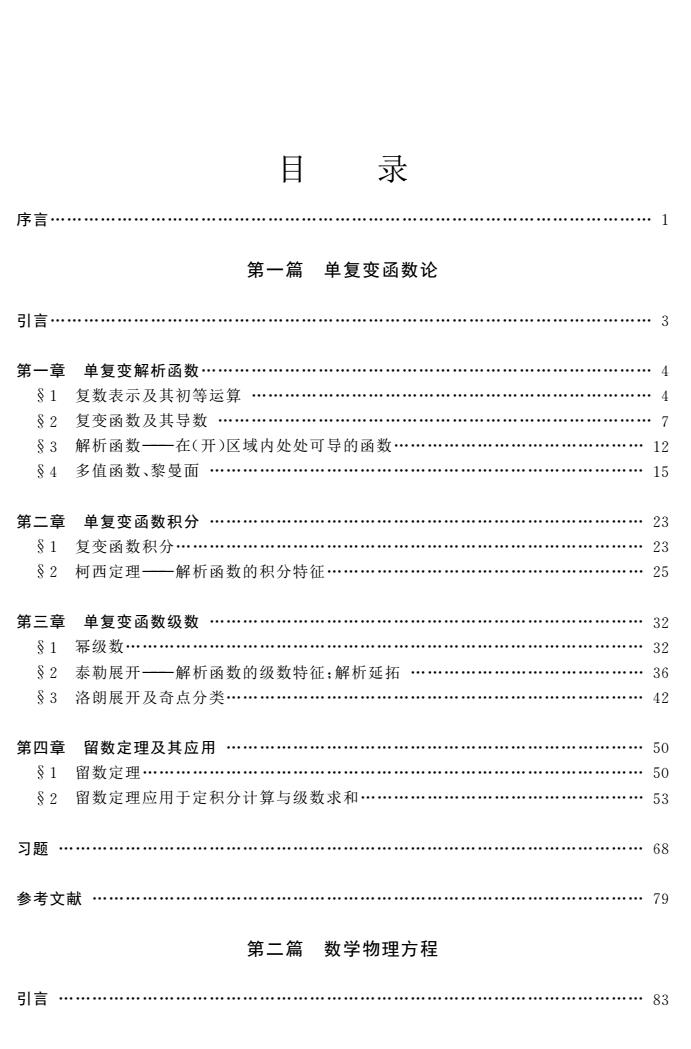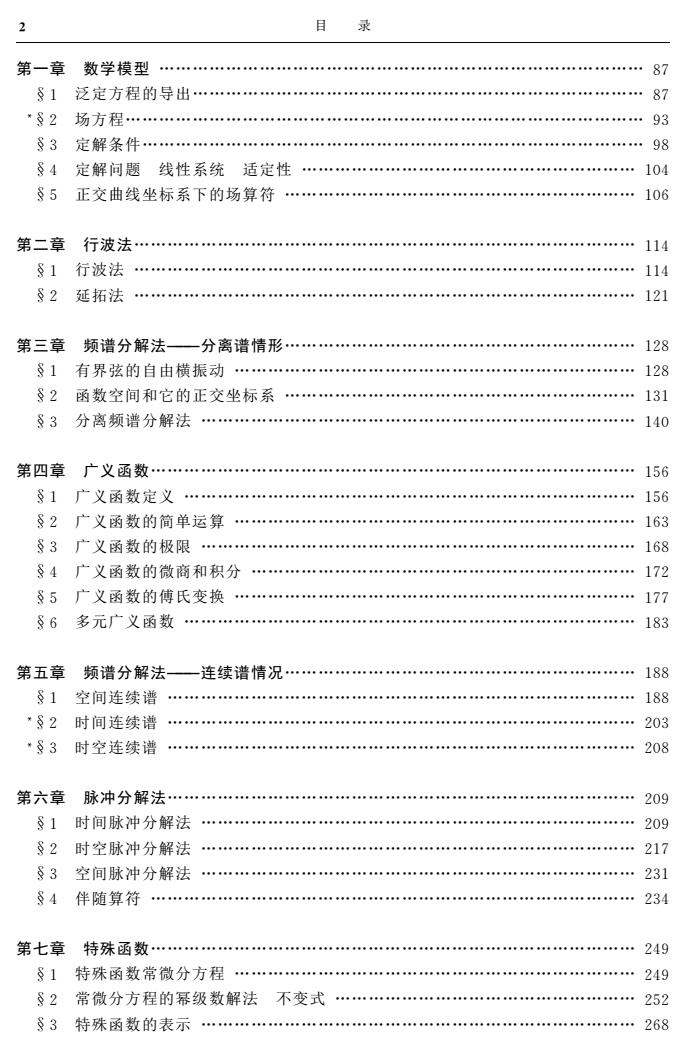
2 Preface recently emerged and fascinating subjects for equations of mathematical physics.Chapter 9 covers the inverse scattering perturbation theory,the method of formal parameter expansion and Gel'fand-Levitan-Marchenko method on the inverse problem,and Hirota transformations,Backlund transformations and inverse scattering transformations on nonlinear problems. Both differential and integral methods can be used to derive mathematical models,but here only the differential method is adopted. Equations of mathematical physics have very wide subjects.As far as the linear system is concerned,what we have focused here on are second-order linear scalar partial differential equations of hyperbolic,parabolic and elliptic types.Little or no attention is given to vector differential equations,higher than second-order,mixed-type,integral and integro-differential equations.Vector partial differential equations play an increasingly important role in the theories of electro-magnetic waves and elastic waves with the deepening of scientific research,but they are too advanced for the undergraduate.Also no attention is given to the Wiener-Hopf method and other important methods related to the function theory of one complex variable,and many important approximate methods. The third part has six chapters.Wavelet transforms are intermediate ones between Fourier and Impulse transforms.Wavelets are a class of representations of very special importance.Considering their special applications,many restraints must be imposed on the function series of expansion.But the issues follow:Do there exist such function series of expansion that meet these restraints?If so,how can they (i.e.,wavelets)be constructed?And do they also have a fast algorithm,which is analogous to FFT? In the first chapter of the third part,wavelets'definitions are given and whys for putting so many restraints on wavelets are expounded.The subsequent four chapters are devoted to the above-mentioned three issues and the last chapter discuses wavelets applications to approximate solution for equations of mathematical physics besides mentioning briefly some other applications. Wavelets'rapid development just occurred after 1988.Now their use has almost become ubiquitous in every domain in natural sciences,including every branch of physics. The knowledge of wavelet transforms is urgent to be spread among undergraduates, graduates and researchers of natural sciences.But up to now,wavelets are still mysterious to many physical workers and engineers.In the author's point of view,there are three reasons for such a mystery.Two of them are objective:First,functional analysis is involved,and second,there are many classes of wavelets,almost each of which has also many members,and those wavelets meeting required constraints have only numerical and/ or geometrical representations,and no analytical representation.The third is subjective: Many problems-formulation are very long and it is sure to result in confusion of idea and pproach for someone to seek a solution to a problem in haste without knowing it clearly and completely.The author tries to address these problems in simple terms
recentlyemergedandfascinatingsubjectsforequationsofmathematicalphysics.Chapter9 coverstheinverse scattering perturbation theory,the method offormal parameter expansionandGelfandLevitanMarchenko methodontheinverseproblem,and Hirota transformations,Bcklund transformations andinverse scattering transformations on nonlinearproblems. Bothdifferentialandintegralmethodscanbeusedtoderivemathematicalmodels,but hereonlythedifferentialmethodisadopted. Equationsof mathematicalphysicshavevery widesubjects.Asfarasthelinear systemisconcerned,whatwehavefocusedhereonaresecondorderlinearscalarpartial differentialequationsofhyperbolic,parabolicandelliptictypes.Littleornoattentionis giventovectordifferentialequations,higherthansecondorder,mixedtype,integraland integrodifferentialequations.Vectorpartialdifferentialequationsplayanincreasingly importantroleinthetheoriesofelectromagnetic wavesand elastic waves withthe deepeningofscientificresearch,buttheyaretooadvancedfortheundergraduate.Alsono attentionisgiventotheWienerHopfmethodandotherimportantmethodsrelatedtothe functiontheoryofonecomplexvariable,andmanyimportantapproximatemethods. Thethirdparthassixchapters.Wavelettransformsareintermediateonesbetween FourierandImpulsetransforms.Waveletsareaclassofrepresentationsofveryspecial importance.Consideringtheirspecialapplications,manyrestraintsmustbeimposedon thefunctionseriesofexpansion.Buttheissuesfollow:Dothereexistsuchfunctionseries ofexpansionthat meettheserestraints?Ifso,how canthey(i.e.,wavelets)be constructed?Anddotheyalsohaveafastalgorithm,whichisanalogoustoFFT? Inthefirstchapterofthethirdpart,waveletsdefinitionsaregivenand whysfor puttingsomanyrestraintsonwaveletsareexpounded.Thesubsequentfourchaptersare devotedtotheabovementionedthreeissuesandthelastchapterdiscuses wavelets applicationsto approximate solution for equations of mathematical physics besides mentioningbrieflysomeotherapplications. Waveletsrapiddevelopmentjustoccurredafter1988.Now theirusehasalmost becomeubiquitousineverydomaininnaturalsciences,includingeverybranchofphysics. Theknowledgeofwavelettransformsisurgenttobespreadamongundergraduates, graduatesandresearchersofnaturalsciences.Butuptonow,waveletsarestillmysterious tomanyphysicalworkersandengineers.Intheauthorspointofview,therearethree reasonsforsucha mystery.Twoofthem areobjective:First,functionalanalysisis involved,andsecond,therearemanyclassesofwavelets,almosteachofwhichhasalso manymembers,andthosewaveletsmeetingrequiredconstraintshaveonlynumericaland/ orgeometricalrepresentations,andnoanalyticalrepresentation.Thethirdissubjective: Manyproblemsformulationareverylonganditissuretoresultinconfusionofideaand approachforsomeonetoseekasolutiontoaprobleminhastewithoutknowingitclearly andcompletely.Theauthortriestoaddresstheseproblemsinsimpleterms. 2 犘狉犲犳犪犮犲

Preface 3 The parts asterisked are not required,but recommended for undergraduates majoring in physics. Methods of Study In tackling a problem,you must know what the problem is,i.e.,problem-formation, it means that you must gain a clear idea of the problem:which are known,measurable or required to be given and which are unknown and to be sought,on that the subsequent proceedings are centered.But you can find out that problem-formation is often hazy and incomplete somewhere else.One example is,some known conditions are not presented at the very start and they are picked up now and then when they are needed in solving the problem.Such a practice is unavoidable in scientific research but it is surely not good for students'studying and should be given up in any textbook.The other is,sometimes in solving a problem,one is unaware of what he wants to reach after and hence he does not understand what will happen afterwards.After clear and complete problem-formation,it is most important to grasp the basic ideas of solving the problem,which are only mathematical (especially geometrical)or physical thoughts,simple and clear,and in which not a great amount of mathematical calculations are involved.To grasp the basic ideas is the key to solving a problem that must be paid great attention to.And then it is followed by the implementation of the basic ideas,in which generally a great amount of mathematical calculations are involved.You will never get boggled down in any tedious calculations if you know the basic ideas well.The final step is to use some tricks to simplify and reduce calculations. In brief,in our studying,we must pay attention to complete problem-formation,the basic ideas of solving the problem,the implementation of such basic ideas and the tricks in the implementation.We must under no circumstances concentrate on mathematical calculations only,must devote great attention to complete problem-formation and the basic ideas of solving the problem and but we do not confuse principles with tricks.The author suggests that readers make a summary on some problems or some chapters and sections, even a whole part,which they feel difficult to understand,according to the four-point method of study. What a student studies is existing knowledge that was discovered and created by somebody else.But if you have a good command of it you must study as if you were an inventor and creator,that is the core of a good method of study. In comparison with existing textbooks on methods of mathematical physics,some big changes in contents,viewpoints and order have been made in this book.Any suggestions, comments and criticisms are welcome for further improvement to this book. The manuscript of this book,especially,of the first two parts,was reviewed by Professor Ni Guangjioing in Fudan University and Professor Wu Chongshi in Beijing University,and the manuscript of the third part was reviewed by Professor Yang Wenchai in the Institute of Geology,the Ministry of Land and Resources of People's Republic of
Thepartsasteriskedarenotrequired,butrecommendedforundergraduatesmajoring inphysics. MethodsofStudy Intacklingaproblem,youmustknowwhattheproblemis,i.e.,problemformation, itmeansthatyoumustgainaclearideaoftheproblem:whichareknown,measurableor requiredtobegivenandwhichareunknownandtobesought,onthatthesubsequent proceedingsarecentered.Butyoucanfindoutthatproblemformationisoftenhazyand incompletesomewhereelse.Oneexampleis,someknownconditionsarenotpresentedat theverystartandtheyarepickedupnowandthenwhentheyareneededinsolvingthe problem.Suchapracticeisunavoidableinscientificresearchbutitissurelynotgoodfor studentsstudyingandshouldbegivenupinanytextbook.Theotheris,sometimesin solvingaproblem,oneisunawareofwhathewantstoreachafterandhencehedoesnot understandwhatwillhappenafterwards.Afterclearandcompleteproblemformation,it is mostimportantto graspthe basicideasofsolvingthe problem,which are only mathematical(especiallygeometrical)orphysicalthoughts,simpleandclear,andinwhich notagreatamountofmathematicalcalculationsareinvolved.Tograspthebasicideasis thekeytosolvingaproblemthatmustbepaidgreatattentionto.Andthenitisfollowed bytheimplementation ofthe basicideas,in which generally a great amount of mathematicalcalculationsareinvolved.Youwillnevergetboggleddowninanytedious calculationsifyouknowthebasicideas well.Thefinalstepistousesometricksto simplifyandreducecalculations. Inbrief,inourstudying,wemustpayattentiontocompleteproblemformation,the basicideasofsolvingtheproblem,theimplementationofsuchbasicideasandthetricksin theimplementation. We must under no circumstances concentrate on mathematical calculationsonly,mustdevotegreatattentiontocompleteproblemformationandthebasic ideasofsolvingtheproblemandbutwedonotconfuseprincipleswithtricks.Theauthor suggeststhatreadersmakeasummaryonsomeproblemsorsomechaptersandsections, evenawholepart,whichtheyfeeldifficulttounderstand,accordingtothefourpoint methodofstudy. Whatastudentstudiesisexistingknowledgethatwasdiscoveredandcreatedby somebodyelse.Butifyouhaveagoodcommandofityoumuststudyasifyouwerean inventorandcreator,thatisthecoreofagoodmethodofstudy. Incomparisonwithexistingtextbooksonmethodsofmathematicalphysics,somebig changesincontents,viewpointsandorderhavebeenmadeinthisbook.Anysuggestions, commentsandcriticismsarewelcomeforfurtherimprovementtothisbook. Themanuscriptofthisbook,especially,ofthefirsttwoparts,wasreviewedby ProfessorNiGuangjioingin Fudan Universityand Professor Wu Chongshiin Beijing University,andthemanuscriptofthethirdpartwasreviewedbyProfessorYangWenchai intheInstituteofGeology,theMinistryofLandandResourcesofPeoplesRepublicof 犘狉犲犳犪犮犲 3

Preface China and Professor Li Shixiong in Anhui University.I would like to express my thanks to them for their valuable suggestions. I would also like to express my thanks to Shanghai Scientific and Technical Publishers for its help with the present publication. I owe a lot to my wife Xiae Zhang,who continuously gave me her encouragement and support throughout the preparation of this book. In addition,I am grateful to the National Natural Science Foundation of China for their financial support of the inverse scattering research projects. The book is dedicated to my mother. NanKai University Tianjin People's Republic of China Zhengiu Lu
ChinaandProfessorLiShixionginAnhuiUniversity.Iwouldliketoexpressmythanksto themfortheirvaluablesuggestions. IwouldalsoliketoexpressmythankstoShanghaiScientificandTechnicalPublishers foritshelpwiththepresentpublication. IowealottomywifeXiaeZhang,whocontinuouslygavemeherencouragementand supportthroughoutthepreparationofthisbook. Inaddition,Iam gratefultotheNationalNaturalScienceFoundationofChinafor theirfinancialsupportoftheinversescatteringresearchprojects. Thebookisdedicatedtomymother. NanKaiUniversity Tianjin PeoplesRepublicofChina ZhenqiuLu 4 犘狉犲犳犪犮犲

目 录 序言 第一篇单复变函数论 引言… 第一章单复变解析函数……4 §1复数表示及其初等运算 00带4中04”5中00+中40:甲年05”…” §2复变函数及其导数……………………7 83解析函数 一在(开)区域内处处可导的函数………12 S4多值函数、黎曼面… 15 第二章单复变函数积分 §1复变函数积分………… 23 S2柯西定理一解析函数的积分特征… 25 第三章单复变函数级数 32 1幂级数……………32 §2泰勒展开一解析函数的级数特征:解析延拓…………36 §3洛朗展开及奇点分类……42 第四章留数定理及其应用 50 1留数定理 50 §2留数定理应用于定积分计算与级数求和… 习题……… 68 参考文…79 第二篇数学物理方程 引言 83
目 录 序言……………………………………………………………………………………………… 1 第一篇 单复变函数论 引言……………………………………………………………………………………………… 3 第一章 单复变解析函数……………………………………………………………………… 4 §1 复数表示及其初等运算 ……………………………………………………………… 4 §2 复变函数及其导数 …………………………………………………………………… 7 §3 解析函数———在(开)区域内处处可导的函数……………………………………… 12 §4 多值函数、黎曼面 …………………………………………………………………… 15 第二章 单复变函数积分 …………………………………………………………………… 23 §1 复变函数积分………………………………………………………………………… 23 §2 柯西定理———解析函数的积分特征………………………………………………… 25 第三章 单复变函数级数 …………………………………………………………………… 32 §1 幂级数………………………………………………………………………………… 32 §2 泰勒展开———解析函数的级数特征;解析延拓 …………………………………… 36 §3 洛朗展开及奇点分类………………………………………………………………… 42 第四章 留数定理及其应用 ………………………………………………………………… 50 §1 留数定理……………………………………………………………………………… 50 §2 留数定理应用于定积分计算与级数求和…………………………………………… 53 习题 …………………………………………………………………………………………… 68 参考文献 ……………………………………………………………………………………… 79 第二篇 数学物理方程 引言 …………………………………………………………………………………………… 83

2 录 第一章数学模型……… …87 1泛定方程的导出………87 S2场方程………………93 §3定解条件………98 §4定解问题线性系统适定性 … 104 5正交曲线坐标系下的场算符………… 106 第二章行波法…114 S1行波法… 114 2延拓法 …… 121 第三章频谱分解法一 —分离谱情形…128 §1有界弦的自由横振动………128 82函数空间和它的正交坐标系 131 §3分离频谱分解法… 140 第四章广义函数……… 156 §1广义函数定义………………… 156 §2广义函数的简单运算………………… 163 §3广义函数的极限… 168 §4广义函数的微商和积分 172 5广义函数的傅氏变换… 177 6多元广义函数… 183 第五章频谱分解法一连续谱情况 188 §1空间连续谱 188 2时间连续谱… 203 §3时空连续谱…………208 第六章脉冲分解法… 209 §1时间脉冲分解法 209 §2时空脉冲分解法 217 §3空间脉冲分解法 231 84伴随算符… 234 第七章特殊函数……………249 §】特殊函数常微分方程…249 S2常微分方程的幂级数解法不变式……252 §3特殊函数的表示……268
第一章 数学模型 …………………………………………………………………………… 87 §1 泛定方程的导出……………………………………………………………………… 87 §2 场方程………………………………………………………………………………… 93 §3 定解条件……………………………………………………………………………… 98 §4 定解问题 线性系统 适定性 …………………………………………………… 104 §5 正交曲线坐标系下的场算符 ……………………………………………………… 106 第二章 行波法……………………………………………………………………………… 114 §1 行波法 ……………………………………………………………………………… 114 §2 延拓法 ……………………………………………………………………………… 121 第三章 频谱分解法———分离谱情形……………………………………………………… 128 §1 有界弦的自由横振动 ……………………………………………………………… 128 §2 函数空间和它的正交坐标系 ……………………………………………………… 131 §3 分离频谱分解法 …………………………………………………………………… 140 第四章 广义函数…………………………………………………………………………… 156 §1 广义函数定义 ……………………………………………………………………… 156 §2 广义函数的简单运算 ……………………………………………………………… 163 §3 广义函数的极限 …………………………………………………………………… 168 §4 广义函数的微商和积分 …………………………………………………………… 172 §5 广义函数的傅氏变换 ……………………………………………………………… 177 §6 多元广义函数 ……………………………………………………………………… 183 第五章 频谱分解法———连续谱情况……………………………………………………… 188 §1 空间连续谱 ………………………………………………………………………… 188 §2 时间连续谱 ………………………………………………………………………… 203 §3 时空连续谱 ………………………………………………………………………… 208 第六章 脉冲分解法………………………………………………………………………… 209 §1 时间脉冲分解法 …………………………………………………………………… 209 §2 时空脉冲分解法 …………………………………………………………………… 217 §3 空间脉冲分解法 …………………………………………………………………… 231 §4 伴随算符 …………………………………………………………………………… 234 第七章 特殊函数…………………………………………………………………………… 249 §1 特殊函数常微分方程 ……………………………………………………………… 249 §2 常微分方程的幂级数解法 不变式 ……………………………………………… 252 §3 特殊函数的表示 …………………………………………………………………… 268 2 目 录